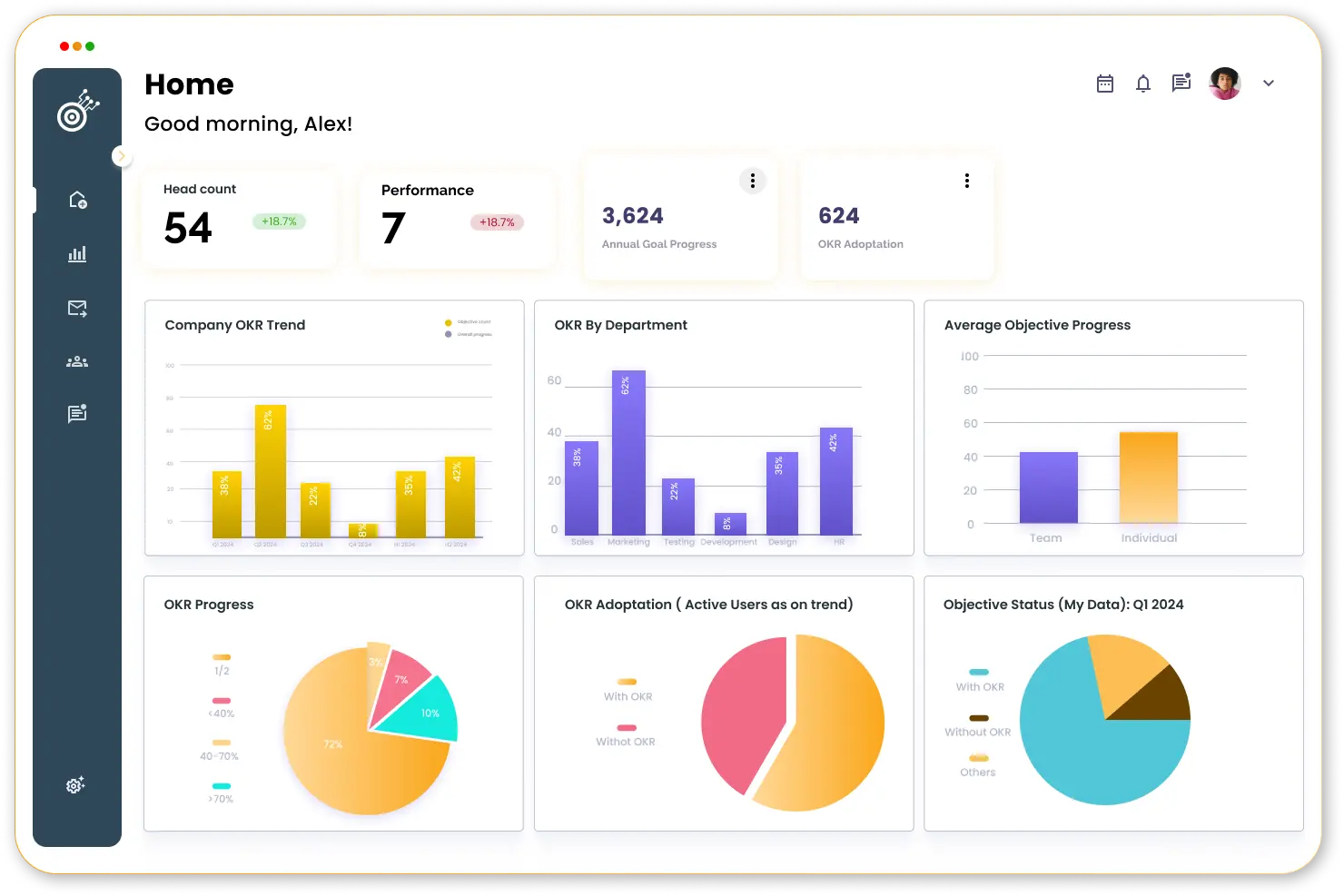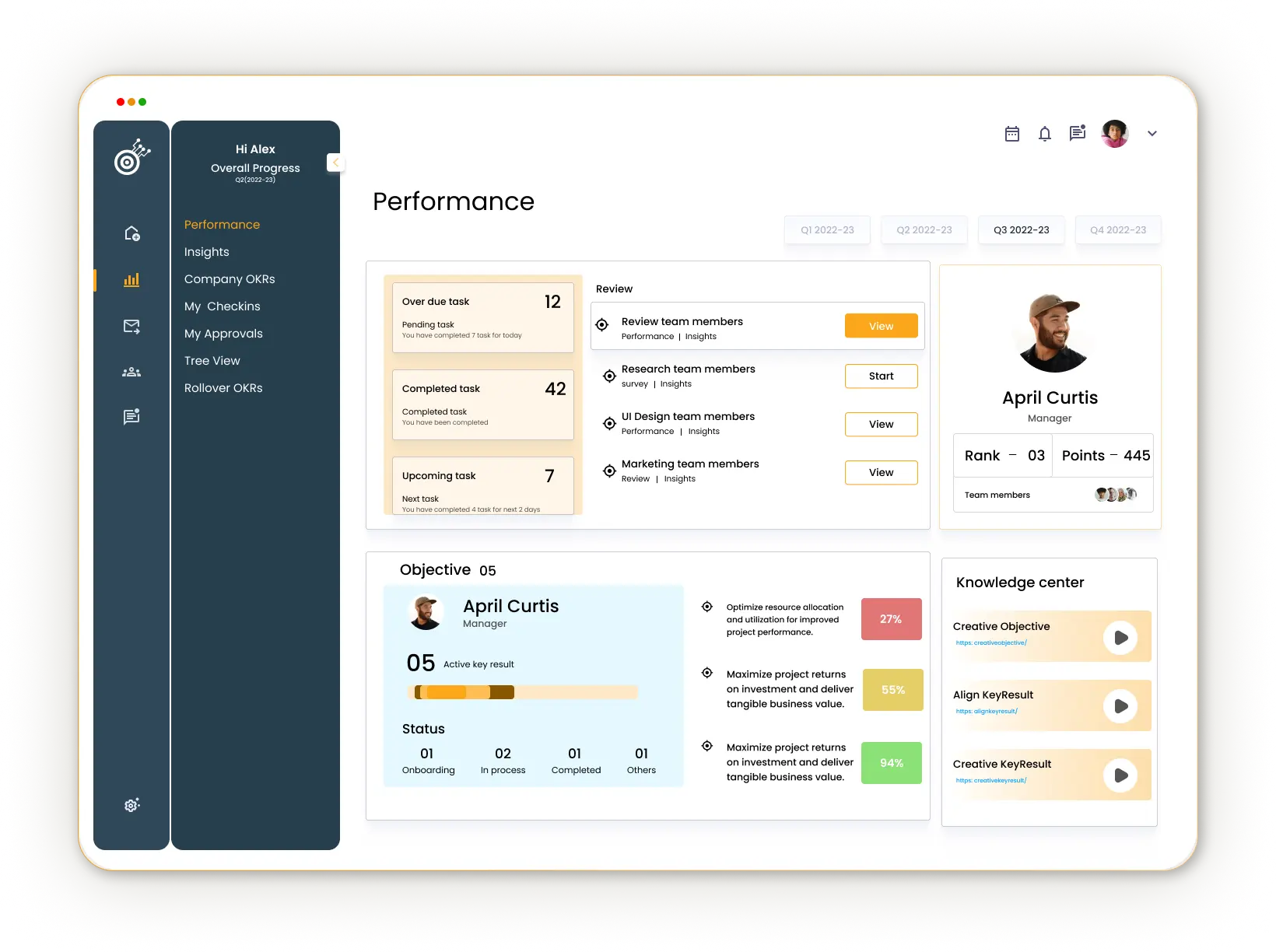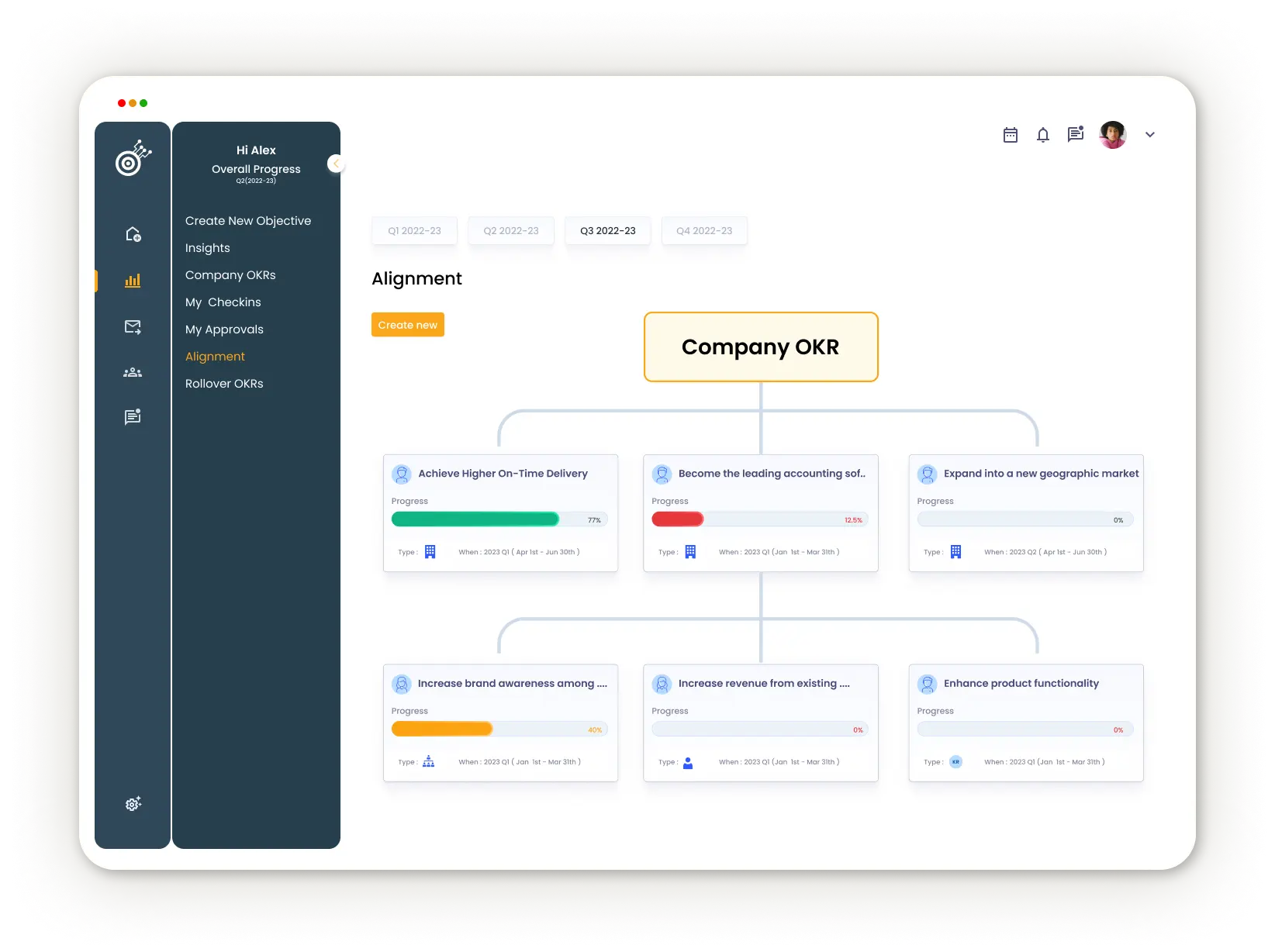Fast-moving businesses typically strive for optimal team performance as they race to outdo rivals Amidst this quest, the Objectives and Key Results (OKR) methodology has emerged as a potent catalyst, aligning collective efforts toward measurable milestones.
However, the true potential of this framework is unlocked when coupled with a robust OKR tracker, a specialized tool designed to streamline OKR goal-setting, progress monitoring, and performance analysis. This guide is an all-inclusive piece that explores the impact an OKR tracker has on your team’s productivity and highlights some of its complex advantages that offer practical recommendations on how to incorporate it effortlessly.
Table of Contents
Demystifying the OKR Methodology
Before looking into the role played by an OKR tracker, one must have at least basic understanding of what constitutes a framework. Setting goals using Objectives and Key Results (OKRs) means having two key elements involved.
Objectives encapsulate the overarching, aspirational targets that inspire and propel teams forward. They are qualitative in nature and designed to challenge and stimulate innovative thinking. For instance, an objective for a marketing team could be “Amplify brand resonance across digital channels.”
Key Results, on the other hand, are the quantifiable metrics that serve as indicators of progress toward the corresponding objective. They provide tangible, measurable benchmarks that allow teams to track their performance objectively. Continuing with the marketing example, a key result could be “Achieve a 30% increase in website traffic from targeted social media campaigns within the next quarter.”
On the other hand, key results are detailed metrics-oriented descriptions that indicate when an objective has been achieved.
The Pivotal Role of an OKR Tracker
While the OKR methodology lays a solid foundation for OKR goal-setting and progress tracking, an OKR tracker elevates this framework to new heights of efficiency and effectiveness. This specialized software solution acts as a centralized command center, empowering teams to streamline the entire OKR lifecycle, from objective formulation to performance analysis.
1. Structured Goal-Setting

An OKR tracker facilitates a structured approach to goal-setting, ensuring that objectives and key results are clearly defined, aligned with organizational priorities, and visible to all stakeholders. By providing a dedicated platform for collaborative objective creation, teams can engage in constructive discussions, refine their targets, and establish a shared understanding of the desired outcomes.
2. Real-Time Progress Monitoring

One of the most significant advantages of an OKR tracker is its ability to provide real-time visibility into progress toward key results. Team members can regularly update their achievements, enabling managers and leaders to monitor performance in real time. This transparency fosters a culture of accountability and allows timely course corrections when deviations from the intended trajectory are detected.
3. Comprehensive Performance Analysis

Apart from monitoring progress, OKR software also has strong analytical features that allow teams to go deeper into their performance data. This is achieved through configurable reports and user-friendly dashboards, which facilitate managers in spotting trends and identifying areas of strength and weaknesses based on processed information in order to optimize future OKR circles.
4. Alignment and Collaboration

Cooperative work is very crucial for any successful team’s outcomes thus an OKR tracker supports this fundamental aspect. It ensures that all the stakeholders have one common place where they can access objectives and key results for better coordination among teams working towards similar goals, thus promoting a cooperative approach.
5. Agility and Adaptability
Precisely, agility is the most important thing to consider in a fast-changing corporate environment. With an OKR tracker, teams are allowed to adjust their objectives as well as Key Results according to the changing market conditions, emerging opportunities, or even modified priorities whenever required by their business environment. Thus, it makes certain that company aims are still relevant with changes taking place while keeping them focused on preventing outdated/misaligned targets from being pursued by teams.
Implementing an OKR Tracker: A Roadmap to Success
Integrating an OKR tracker into your team’s workflow is a journey that requires careful planning and execution. Here’s a roadmap to guide you through the implementation process:
1. Assess Your Team’s Needs and Readiness
Before embarking on the OKR tracker implementation journey, conduct a thorough assessment of your team’s specific requirements and readiness for change. Identify the key challenges and pain points you aim to address and ensure that your team members are receptive to adopting a new goal-setting and performance-tracking methodology.
2. Select the Right OKR Tracker Solution
With a plethora of OKR tracker solutions available in the market, it’s essential to evaluate and select the one that aligns seamlessly with your team’s unique needs and existing technology stack. Include parameters like ease of use, customization features, other tools integration and future scalability in order to make your investment worth.
3. Provide Comprehensive Training and Support
Successful adoption of an OKR tracker hinges on effective training and support. Invest time and resources in educating your team members on the intricacies of the OKR methodology and the functionalities of the chosen OKR tracker solution. Encourage openness as you handle issues which encourage learning always for smooth transition
4. Establish Clear Processes and Governance
Define clear processes and governance structures around the use of the OKR tracker. Determine roles and responsibilities, establish cadences for progress updates, and outline guidelines for objective formulation and key result measurement. This structured approach will ensure consistency and accountability across the team.
5. Foster Continuous Improvement and Adaptation
Embrace an iterative mindset when implementing an OKR tracker. Regularly solicit feedback from team members, analyze performance data, and refine your processes as needed. Celebrate successes and learn from challenges, continuously adapting and optimizing your approach to maximize the benefits of the OKR tracker.
Objectives: Crafting Aspirational Targets
At the heart of the OKR framework lie the objectives – the ambitious, inspiring targets that propel teams forward. The making of good objectives is an art that needs to be done cautiously in alignment with the goals of a company. Here are some guiding principles for setting impactful objectives
1. Align with Organizational Goals
Your team’s objectives must be anchored within the context of wider organizational goals and strategic priorities. This kind of agreement ensures a unified approach, which means individual team inputs align with company’s mission and vision.
2. Foster Inspiration and Challenge
Objectives should be aspirational and challenging, pushing teams to stretch their capabilities and think beyond the confines of the status quo. While ambitious, these targets should remain achievable, striking a delicate balance between ambition and feasibility.
3. Embrace Clarity and Specificity
Well-crafted objectives are clear and specific, leaving no room for ambiguity or misinterpretation. Clearly articulate the desired outcome, ensuring that all team members share a common understanding of the target they are collectively striving towards.
4. Encourage Cross-Functional Collaboration
In today’s open business environment, objectives often go beyond the confines of single groups within an organization. Foster a sense of common purpose through involving various stakeholders from other fields during the process of objective setting so as to promote cross-functional collaboration.
5. Facilitate Adaptability
While objectives should be well-defined and specific, it’s crucial to maintain a degree of flexibility. Incorporate mechanisms for periodic review and adjustment, allowing teams to adapt their objectives in response to changing circumstances or emerging opportunities.
Key Results: Quantifying Success
While objectives provide the aspirational direction, key results serve as the quantifiable milestones that measure progress towards those targets. Crafting meaningful and measurable key results is essential for ensuring the effectiveness of the OKR framework. Here are some best practices for defining impactful key results:
1. Align with Objectives
Ensure that each key result is directly linked to and supports the achievement of its corresponding objective. This alignment ensures that the team’s efforts are focused and purposeful, contributing to the overarching goal.
2. Embrace Measurability
Key results should be quantifiable and measurable, leaving no room for ambiguity or subjectivity. Clearly define the metrics or indicators that will be used to track progress, ensuring that data collection and analysis are feasible and reliable.
3. Set Ambitious yet Achievable Targets
While key results should be challenging, they should also be realistically achievable within the designated timeframe. Strike a balance between ambition and feasibility, encouraging teams to stretch their capabilities while maintaining a sense of motivation and commitment.
4. Incorporate Actionable Steps
Break down each key result into actionable steps or milestones, providing a clear roadmap for execution. This granular approach fosters accountability and enables teams to track progress more effectively, making course corrections as needed.
5. Foster Collaboration and Ownership
Involve team members in the process of defining key results, fostering a sense of ownership and buy-in. Collaborative goal-setting not only ensures that key results are realistic and relevant but also enhances team engagement and commitment.
Crafting OKRs for Company and Team Levels
Effective implementation of the OKR framework requires a cascading approach, where objectives and key results are defined at multiple levels, ensuring alignment and cohesion throughout the organization. Here’s a step-by-step guide to defining OKRs at the company and team levels:
1. Establish Company-Level OKRs
Begin by defining the overarching objectives and key results for the entire organization. These company-level OKRs should reflect the strategic priorities and long-term vision, serving as the guiding beacon for all subsequent team and individual efforts.
2. Cascade to Department and Team Levels
Once the company-level OKRs are established, cascade them down to the department and team levels. Each team should define its objectives and key results, ensuring that they directly contribute to and support the achievement of the broader organizational goals.
3. Involve Cross-Functional Stakeholders
Encourage cross-functional collaboration during the OKR definition process. Involve stakeholders from various departments and teams to ensure that objectives and key results are aligned, avoiding siloed efforts or conflicting priorities.
4. Align Individual Contributions
At the individual level, expand the OKR framework to enable individuals set their own desired goals and key achievements. Such unique OKRs are meant to directly contribute towards team objectives thereby enhancing a feeling of belongingness and responsibility.
5. Foster Transparency and Communication
Maintain transparency throughout the OKR definition process, ensuring that objectives and key results at all levels are visible and accessible to relevant stakeholders. Encourage open communication and feedback loops, allowing for continuous refinement and alignment.
Ongoing Oversight and Adjustment of OKRs: Strategies for Achieving Success
It’s worth noting that it’s through repeated monitoring, adaptation as well as culture of continuous improvement that makes OKR effective. By adopting an incremental approach, teams can ensure that their goals and key results remain realistic, attainable, and consistent with changing business demands. Here are some strategies for successful OKR monitoring and adaptation:
1. Implementing Regular Review Cycles
An important step in successful OKR implementation is having monthly review meetings. At such times, teams can critically evaluate KPIs like site traffic growth or the success rate of marketing endeavors in new markets. This kind of regular check allows an immediate understanding on whether efforts are helpful and consequently timely course correction might be done if needed.
2. Embracing Adaptability
The most prominent feature of any good OKR implementation is being able to adapt to changes that may arise from it. When external conditions change and internal problems occur, objective-setting becomes more flexible than ever before. If KPIs indicate discrepancy from expected results, it is essential for a team to adjust its OKRs so that they remain relevant and attainable.
In addition, fostering a culture of continuous learning and improvement is critical for the success of any organization. Therefore, every OKR cycle ought to be seen as a chance for developing better goal setting techniques as well as execution approaches based on the lessons learnt in earlier experiences. Indeed, encouraging team members to think about their achievements and shortcomings nurtures an environment where there will always be growth and optimization.
3.Foster Open Communication and Collaboration
Supporting an open culture that encourages cooperation in the context of the OKR framework, is important. A process where team members are urged to reflect on and share their experiences, obstacles, as well as ideas about their OKRs, gives rise to a supportive environment, which is founded on the continuous learning curve.
It is very important for team members to openly talk about progress and obstacles related to OKRs. These can take place at team meetings or during one-on-one sessions even within informal settings, thus creating platforms through which valuable insights and strategies can be shared.
4. Embrace Agility and Adaptability
Be agile and adaptable when it comes to your approach towards OKRs. Objectives and key results should be revised based on changing market conditions, new opportunities or shifting corporate priorities if need be. Your OKR framework must have room for flexibility in order to remain relevant and efficient at all times.
5. Celebrate Milestones and Successes
Recognize and celebrate significant milestones and successes achieved throughout the OKR cycle. Acknowledging these accomplishments boosts team morale, reinforces the value of the OKR framework, and fosters a culture of continuous improvement and motivation.
Monitoring Employees’ OKRs with Datalligence
Although the OKR framework is a sound basis for goal-setting and performance management, Datalligence’s OKR tracker goes way further than that by offering an all-inclusive package designed to maximize team effectiveness and productivity.
1. Seamless Integration with Project Management Tools
Datalligence’s OKR tracker seamlessly integrates with popular project management tools like Jira, Asana, and Trello, enabling teams to effortlessly track progress on specific OKRs directly within their existing workflows. This integration streamlines processes, eliminates redundant data entry, and ensures that OKR tracking is a seamless part of your team’s daily operations.
2. Real-Time Monitoring and Engagement Analysis
With real-time monitoring capabilities from Datalligence managers can watch activities within their teams or groups as they happen to ensure efforts are aligned with the set OKRs. This feature offers useful information on how actively employees are working towards their goals showing high productivity areas as well as opportunities for additional support or coaching.
3. Custom Alerts and Comprehensive Reporting
The OKR tracker from Datalligence offers custom alert systems for managers that communicate them with any substantial deviations or key milestones achieved in OKR progress. At the same time, detailed insights into team performance through comprehensive reporting capabilities of this software offer useful metrics for reviewing and tuning OKRs as necessary.
4. Productivity Trends Dashboard
The Productivity Trends Dashboard in Datalligence’s OKR tracker allows managers to observe long-term trends in team productivity. This feature is particularly useful for evaluating the effectiveness of strategies implemented to achieve OKRs and for making data-driven decisions for future OKR cycles.
5. Seamless Integration with Datalligence’s Suite of Tools
Datalligence’s OKR tracker is a part of a suite of tools that are intended to optimize the performance and productivity of a team. Teams can gain a complete picture of their performance by using other solutions offered by Datalligence such as employee monitoring software, time tracking tools, and workforce analytics platforms, among others thereby allowing for intelligent decision making.
Datalligence’s OKR tracker equips managers with the tools to closely monitor and analyze team performance in relation to their OKRs. Whether it’s through tracking real-time engagement, integrating with project management tools, or analyzing productivity trends, Datalligence enables a more informed and effective approach to achieving strategic goals set by OKRs.
Maximizing Productivity with OKR Trackers
In ceasless pursuit of team’s excellence, an OKR tracker, when implemented can dramatically alter the game. Teams are able to unlock their latent talents and strive to achieve greater productivity with this tool by simplifying goals setting, increasing transparency and embracing data-informed decision-making.
As you take steps towards incorporating an OKR tracker into your team’s workflow, never forget that you must buy into a culture of constant improvement. Keep on requesting feedback regularly, studying performance data and revising your processes in order to ensure that the tool remains dynamic and effective in driving team success.
Datalligence, a top provider of cutting-edge workforce management solutions has developed an excellent OKR tracker that will seamlessly slot into your existing workflows and technology stack. Employee monitoring software, time-tracking solutions as well as workforce analytics platforms are some of Datalligence’s tools from which you can get a wholesome picture about how your team is performing allowing informed decision making leading to continuous optimization.
Experience the transformative power of productiveness in terms of alignment and organizational performance when using Datalligence’s OKR tracker with its numerous feature sets










